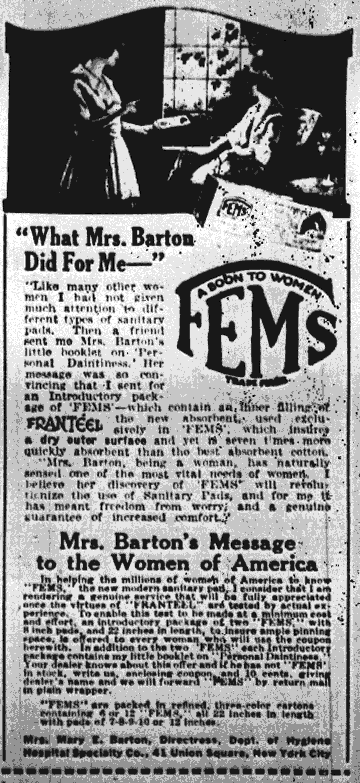See Mary Pauline
Callender, author of the Marjorie May
menarche booklets for girls.
See a prototype
of the first Kotex ad.
See more Kotex items: Ad 1928 (Sears and Roebuck
catalog) - Marjorie
May's Twelfth Birthday (booklet for
girls, 1928, Australian edition; there are
many links here to Kotex items) - 1920s
booklet in Spanish showing disposal method
- box from about
1969 - Preparing
for Womanhood (1920s, booklet for
girls) - "Are you in the
know?" ads (Kotex) (1949)(1953)(1964)(booklet, 1956) -
See more ads on the Ads
for Teenagers main page


|

Women Representatives of Companies
From the very early days of
advertising for menstrual pads and
tampons, sellers used women,
fictional perhaps, to pitch their
products. Can
you imagine a man, pad in hand,
advising women to use them?
(Actually, some have, like here.) Even
though a man probably invented the
first modern commercial
menstruation napkin, and certainly
did the first
commercial tampon with an
applicator, women could
better trust another woman to
understand the problems of their "critical days."
"Critical
days," by the way, an expression
used in several cultures, will get
a separate section of this site in
the future. The German Camelia
menstrual-pad people use it in a pre-World War
II ad.
See also Mary
Pauline Callender, author of
the Marjorie May menarche booklets
for girls.
Below we have two early
appearances of the woman-to-woman
approach, even though I suspect
these, and later, women may have
been speaking with a male voice.
Men run the industry, after all. If alive, will
the real Mrs. Barton and
Nurse Thekla out themselves?
The Camelia ad is at the
bottom of the page (See later
Camelia ads: German
Camelia ad
right before World War ll - Australian
Camelia ad (1952) - French Camelia ad
(1970s) - German Camelia ad
touting disposal bag(1990s)
Large
files, long download!
|
 |
Left: Mrs.
Barton advised readers to
buy Fems
through her booklet "Personal
Daintiness," here in an ad from
McCall's magazine, September 1921.
(Decades later, Sears portrayed a
figure also called Barton to lend
her name to menstrual gear.)
Astute site visitors recall that Kotex
started advertising its disposable
napkin in January 1921. Even more
astute visitors know that
Kimberly-Clark (which Marjorie May's
mother spoke for) sold a product
called Fems
decades later, and that a certain
Ann Barton
popped up in Sears catalogs at the
same time, sweet-talking readers
into buying her pads. Is
there a Fems-to-the-left
connection with Kimberly-Clark?
And could the Barton-to-the-left
be the mother of the Sears Barton?
Folks, this
is drama!
Let's assume that an ad man
invented Mrs. Barton. Why Barton?
I wonder if the public still
remembered Clara
Barton, founder of the
American Red Cross? This would
make the medical connection in
people's minds; nurses, you will
remember, used bandages the
Kimberly-Clark Company made for
soldiers in World War I as
menstrual pads, giving birth to
Kotex.
Manufacturers
loved, and love, to use medical
authority, as we will see
in the Camelia ad below, from Germany,
where people respected it even
more.
The
Camelia ad is below.
|
|

Many thanks to
Professor
Domenico Pecorari,
Director of Obstetrics and
Gynecology, Policlinic Hospital
of the Medical School,
University of Verona, Italy, for
sending me the valuable article
"Befleckte
Weiblichkeit - Spuren
tradierter Menstruationsmythen
in der Werbung für
Produkte der weiblichen
intimhygiene," by Dr. med. Jael
Backe of the
Universitätsfrauenklinik
Würzburg, Germany,
published in
Gynäkologisch-geburtshilfliche
Rundschau 1997; 37:30-38. The
above Camelia ad came from that
article.
|
(Left) Finger-wagging Schwester
Thekla (also
in a 1928 Dutch booklet)
(Schwester means sister in
German, the word used for nurse in
that country - in full it's
Krankenschwester - , but which
Americans use for nun; nurses'
uniforms are related to nun's
habits, which remind us of the
origins of hospitals) advised
Germans to buy the disposable pad
Camelia, a product available five
years after Kotex, and which, like
Kotex, exists today. (But
Kimberly-Clark, the maker of
Kotex, bought Camelia in 1998).
The word Camelia
is one of a long line of flower
associations in menstruation and
hygiene advertising, and
also in popular culture. (See a
flower's use in menstrual
cup advertising, the shape
of a tulip mimicking the cup.)
(Germans,
I unnecessarily note, wag their
fingers from left to right and
back again, whereas Americans
move the finger away and towards
their bodies.)
Kotex and other companies used
the cross - note again the
connection between medicine and
the Christian development of
hospitals - on its boxes and in
advertising. This encouraged the
connection between sickness and
menstruation in the public mind,
as well as the authority of
doctors and nurses. And did it
- Good Grief! -
subliminally suggest that it was
the Christian thing to use?
Anyway, the words above Camelia
translate as "Enables simplest
and discrete destruction."
A woman who bought Camelia found
a slip of
paper in the box. When
she needed more pads, she silently
handed the slip to a store clerk;
signs in drug stores advised women
to ask for a female
clerk when buying Camelia. The
slip said, "Please
sell
me a box of Camelia."
American
women buying Modess pads
could also present a slip to
clerks they clipped from ads.
|
See Mary Pauline
Callender's Marjorie May menarche
booklets for girls.
© 1999 Harry
Finley. It is illegal to reproduce or
distribute work on this Web site in any
manner or medium
without written permission of the author.
Please report suspected violations to hfinley@mum.org
|